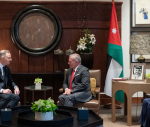You are here
A tale of Maan
Apr 12,2014 - Last updated at Apr 12,2014
Beyond all the World Bank reports, Central Bank projections and pages upon pages of heavily scrutinised employment statistics, to get a true picture of Jordan’s economic health all one needs is an afternoon in the Maan Governorate.
Like clockwork, traffic stops in Maan at 2pm as dozens of unemployed youths fill the streets nearly daily, asking the government to solve their two-year job search.
In a near-daily ritual that became almost a routine, shopkeepers lean against the door frames of their empty storefronts, watching their sons, brothers, cousins and friends raise economic complaints that have become so common residents seem reluctant to waste their breath to repeat them.
Despite the day being half-over, many have yet to make a single sale as rising prices of basic goods pushed them out of reach of residents, whose average salary hovers around JD300.
Even kaek Maani, the syrupy sweet, lard-laden biscuits lovingly baked by Maan housewives and handed out to Hajj pilgrims as a trademark of the city’s hospitality for generations, has nearly doubled in price to a dinar a bag.
The price remains symbolic, however. Residents continue to “treat” their guests and empty-handed customers to bag upon bag of free samples, without a single coin passing through the hands of baker, merchant or resident.
As one Maan shopkeeper put it, “the souk is dead, but we refuse to bury it”.
On the dusty outskirts of Maan, in the village of Al Husseinieh, residents face concerns of a different variety.
Long reliant on the army and public sector for employment, the village’s bedouin population has to budget the recently received fuel support handouts, debating how to best stretch each dinar to cover school textbook fees, hospital fees and the weekly grocery bill.
Fuel has long been stricken off family budgets in the village where average salaries and retirement packages stand at some JD400 a month. Many resort to the village’s lone Toyota coaster bus and passing cargo trucks for transportation.
As one-way trips to the “big city” reached JD3 in private vehicles, many residents have rationed their once daily 30-kilometre commute to Maan to once-a-month visits.
Amid increasing economic uncertainty in the southern governorate, IMF envoy Kristina Kostial broke the good news that with economic growth projections of 4 per cent, Jordan’s economy is destined to “strengthen” in 2014.
Maanis will tell a different story: if economic conditions in Jordan are improving, the Jordanian people certainly aren’t feeling it.
Some JD210 million is spent to help citizens shoulder rising liberalised fuel prices, still many have been left to worry about higher electricity, telecommunication and water bills.
Fiscal restraint and an “amenable investment climate” are likely to bring little relief to the Jordanian newlyweds spending restless nights worrying about finding a home for the new family. Average rents more than doubled even in remote corners such as Maan, where even the most modest apartment cannot be found for less than JD250 a month.
With food prices having risen 10 per cent in the first three months of the year, it is hard to find a voice of confidence among Jordanian consumers tongue tied by sticker shock.
And therein lies the deeper, distressing moral of the Maan tale: despite much fanfare, the government’s austerity measures have largely failed.
Despite raising electricity rates by an average of 14 per cent in mid-2013, authorities failed to make a dent in the National Electric Power Company’s bloated budget deficit — which still stands at some JD4 billion.
A little over a year after the controversial lifting of fuel subsidies and the introduction of a series of tax increases on telecommunication, apparel and other goods, the budget deficit is projected to go beyond $2 billion, compared to $2 billion in 2013.
Unemployment is forecast to rise to 14 per cent in 2014 and government expenditures likely to mirror those of 2013, yet the government succeeded neither in creating job opportunities nor in creating a fiscal breathing room in what economists are calling a “vicious economic cycle”.
With true purchasing power largely stagnant, and the average income of a Jordanian household set to dip below the JD5,000 mark, economists of all stripes agree that the government options are limited.
Further tax increases will likely ignite an already under-pressure public, while attempts to increase government hiring or handouts would only lead the country further down the road to fiscal ruin.
The only true answer to the Kingdom’s economic woes is long-term planning and restructuring, such as the 10-year economic blueprint called for by His Majesty King Abdullah in a letter to the government last week.
A series of strategic projects aimed at creating employment, alleviating the country’s water crisis and ending its reliance on imported energy — set to cost the government JD4 billion in 2014 alone — will be the saving grace to a population that has been stretched beyond its means.
Maan, and the rest of Jordan, needs and deserves a long-term strategy that prioritises “decent living standards and a promising bright future for the men and women of our beloved Jordan” over faint praise on the country’s IMF report card.
But short term, the path will be anything but easy.
Decision makers must tackle the growing burden placed by the rapidly growing Syrian refuge population, projected to cost the country JD3 billion, adding to an even fiercer housing crunch and increased competition over low-paying job opportunities.
Yet, perhaps, as best put by Sheikh Fayez Al Jazi — Al Husseinieh resident and prominent leader of the Hweitat tribe — the government’s most pressing task will be to prevent the loss of a less tangible, more important victim of the country’s widening economic crisis: its hospitality.












